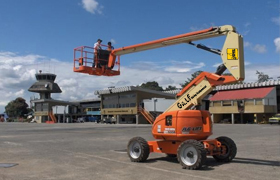Telescopic Mobile Cranes

A crane is a type of machine, generally equipped with a hoist, wire ropes, and sheaves, that can be used both to lift and lower materials and to move them horizontally. It is mainly used for lifting heavy things and transporting them to other places. It uses one or more simple machines to create mechanical advantage and thus move loads beyond the normal capability of a human. Cranes are commonly employed in the transport industry for the loading and unloading of freight, in the construction industry for the movement of materials and in the manufacturing industry for the assembling of heavy equipment.
Articulated Boom Lift / Man Lift

Articulating boom lifts (knuckle booms) are used for reaching up and over machinery, equipment, and other obstacles mounted on floors, and for reaching other elevated positions not easily approached by a straight (telescopic) boom lift. The machine's turntable may be rotated 360 degrees in either direction. The boom can be raised or lowered from vertical to below horizontal, and extended (telescoped) while the work platform remains horizontal and stable. It can be maneuvered forward or backward and steered in any direction by the operator from the work platform, even while the basket is elevated.
Telehanders / Boom Loaders

A telescopic handler, or telehandler, is a machine widely used in agriculture and industry. It is similar in appearance and function to a forklift but is more a crane than forklift, with the increased versatility of a single telescopic boom that can extend forwards and upwards from the vehicle. On the end of the boom the operator can fit one of several attachments, such as a bucket, pallet forks, muck grab, or winch.
In industry the most common attachment for a tele-handler is pallet forks and the most common application is to move loads to and from places unreachable for a conventional forklift. For example, telehandlers have the ability to remove palletised cargo from within a trailer and to place loads on rooftops and other high places. The latter application would otherwise require a crane, which is not always practical or time-efficient.




